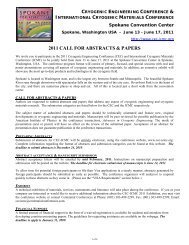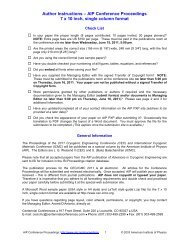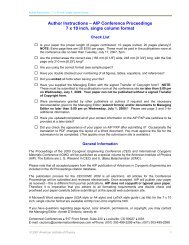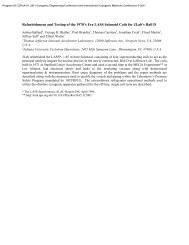CEC Abstracts in PDF format (as of 7/3/07) - CEC-ICMC 2013
CEC Abstracts in PDF format (as of 7/3/07) - CEC-ICMC 2013
CEC Abstracts in PDF format (as of 7/3/07) - CEC-ICMC 2013
Create successful ePaper yourself
Turn your PDF publications into a flip-book with our unique Google optimized e-Paper software.
<strong>CEC</strong> 20<strong>07</strong> - <strong>Abstracts</strong><br />
Friday, <strong>07</strong>/20/<strong>07</strong> Oral 9:15am -<br />
10:45am<br />
C4-B Superconduct<strong>in</strong>g RF Cavities and<br />
Cryosystems - II<br />
C4-B-01 ILC Cryogenic Systems Reference Design<br />
T. Peterson, M. Geynisman, A. Klebaner, J.<br />
Theilacker, Fermilab; V. Parma, L. Tavian, CERN.<br />
A Global Design Effort began <strong>in</strong> 2005 to study a TeV scale electronpositron<br />
l<strong>in</strong>ear accelerator b<strong>as</strong>ed on superconduct<strong>in</strong>g radio-frequency<br />
(RF) technology, called the International L<strong>in</strong>ear Collider (ILC). In<br />
early 20<strong>07</strong>, the design effort culm<strong>in</strong>ated <strong>in</strong> a reference design for the<br />
ILC, closely b<strong>as</strong>ed on the earlier TESLA design. The ILC will consist<br />
<strong>of</strong> two 250 GeV l<strong>in</strong>acs, which provide positron-electron collisions for<br />
high energy physics research. The particle beams will be accelerated<br />
to their f<strong>in</strong>al energy <strong>in</strong> superconduct<strong>in</strong>g niobium RF cavities operat<strong>in</strong>g<br />
at 2 Kelv<strong>in</strong>. At a length <strong>of</strong> about 12 km each, the ma<strong>in</strong> l<strong>in</strong>acs will be<br />
the largest cryogenic systems <strong>in</strong> the ILC. Positron and electron<br />
sources, damp<strong>in</strong>g r<strong>in</strong>gs, and beam delivery systems will also have a<br />
large number and variety <strong>of</strong> other superconduct<strong>in</strong>g RF cavities and<br />
magnets, which require cool<strong>in</strong>g at liquid helium temperatures. Ten<br />
large cryogenic plants with 2 Kelv<strong>in</strong> refrigeration are envisioned to<br />
cool the ma<strong>in</strong> l<strong>in</strong>ac and the electron and positron sources. Three<br />
smaller cryogenic plants will cool the damp<strong>in</strong>g r<strong>in</strong>gs and beam<br />
delivery system components predom<strong>in</strong>ately at 4.5 K. This paper<br />
describes the cryogenic systems concepts for the ILC.<br />
C4-B-02 Installation and Commission<strong>in</strong>g <strong>of</strong> the<br />
Superconduct<strong>in</strong>g RF L<strong>in</strong>ac Cryomodules for the ERLP<br />
A.R. Goulden, R. Bate, CCLRC Daresbury<br />
Laboratory UK; R.K. Buckley, S.M. Pattalwar,<br />
CCLRC Daresbury Labpratory UK.<br />
An Energy Recovery L<strong>in</strong>ac Prototype (ERLP) is currently be<strong>in</strong>g<br />
constructed at Daresbury Laboratory (UK), to promote the necessary<br />
skills <strong>in</strong> science & technology, particularly <strong>in</strong> photocathode electron<br />
gun and Super Conduct<strong>in</strong>g RF, to enable the construction <strong>of</strong> a fourth<br />
generation light source, b<strong>as</strong>ed on energy recovery l<strong>in</strong>acs-4GLS [1].<br />
The ERLP uses two identical cryomodules, one <strong>as</strong> a booster cavity<br />
accelerat<strong>in</strong>g the beam to 8.5 MeV, the other <strong>as</strong> a l<strong>in</strong>ac module <strong>in</strong> the<br />
re-circulat<strong>in</strong>g loop with an energy ga<strong>in</strong> <strong>of</strong> 24.5 MeV. Each module<br />
consists <strong>of</strong> two n<strong>in</strong>e cell cavities operat<strong>in</strong>g at a frequency <strong>of</strong> 1.3GHz<br />
and a temperature <strong>of</strong> 2K. As there is no energy recovery <strong>in</strong> the booster<br />
it requires a peak power <strong>of</strong> 53kW; where<strong>as</strong> the l<strong>in</strong>ac module only<br />
requires 8kW. The RF power is supplied by 4 IOTs. The maximum<br />
heat load or the cool<strong>in</strong>g power required <strong>in</strong> the Super Conduct<strong>in</strong>g RF<br />
system is 180W at 2K and is achieved <strong>in</strong> two stages: a LN2 precooled<br />
L<strong>in</strong>de TCF050 liquefier produces liquid helium at 4.5K,<br />
followed by a 2K cold box consist<strong>in</strong>g <strong>of</strong> a JT valve, recuperator and<br />
an external room temperature vacuum pump<strong>in</strong>g system.<br />
This presentation reports the experience ga<strong>in</strong>ed dur<strong>in</strong>g, <strong>in</strong>stallation,<br />
commission<strong>in</strong>g and the <strong>in</strong>itial operation <strong>of</strong> the cryomodules.<br />
C4-B-03 Initial Operat<strong>in</strong>g Experience for the ISAC-II<br />
SC-L<strong>in</strong>ac at TRIUMF<br />
I. Sekachev, W. Andersson, R. Laxdal, G. Stanford,<br />
TRIUMF.<br />
A first stage <strong>of</strong> the heavy ion superconduct<strong>in</strong>g l<strong>in</strong>ac cryogenic system<br />
compris<strong>in</strong>g a 500W LHe refrigerator and distribution system h<strong>as</strong> been<br />
<strong>in</strong>stalled and started operation at TRIUMF. The early experience with<br />
the cryogenic systems <strong>in</strong>clud<strong>in</strong>g data <strong>of</strong> the thermal loads and<br />
refrigerator performance will be presented.<br />
C4-B-04 Operation <strong>of</strong> the Superconduct<strong>in</strong>g L<strong>in</strong>ac at the<br />
Spallation Neutron Source.*<br />
I. E. Campisi, F. C<strong>as</strong>agrande, M. Cr<strong>of</strong>ford, M.<br />
Howell, Y. Kang, S. H. Kim, Z. Kursun, P. Ladd, D.<br />
Stout, W. Strong, ORNL/SNS; M.S. Champion, FNAL.<br />
At the Spallation Neutron Source, the first fully operational pulsed<br />
superconduct<strong>in</strong>g l<strong>in</strong>ac h<strong>as</strong> been active for about two years. Dur<strong>in</strong>g this<br />
period, stable beam operation at 4.4 K h<strong>as</strong> been achieved with beam<br />
for repetition rates up to 15 Hz. Lower temperatures have been<br />
occ<strong>as</strong>ionally atta<strong>in</strong>ed to study conditions required to support full beam<br />
power delivery, which requires 60 Hz RF and beam pulses <strong>of</strong> 1<br />
millisecond. A large amount <strong>of</strong> data h<strong>as</strong> been collected on the pulsed<br />
behavior <strong>of</strong> cavities and cryomodules at various repetition rates and at<br />
various temperatures. This experience will be <strong>of</strong> great value <strong>in</strong><br />
determ<strong>in</strong><strong>in</strong>g future optimizations <strong>of</strong> SNS <strong>as</strong> well <strong>in</strong> guid<strong>in</strong>g <strong>in</strong> the<br />
design and operation <strong>of</strong> future pulsed superconduct<strong>in</strong>g l<strong>in</strong>acs.<br />
This paper describes the details <strong>of</strong> the cryogenic system and RF<br />
properties <strong>of</strong> the SNS superconduct<strong>in</strong>g l<strong>in</strong>ac.<br />
*SNS is managed by UT-Battelle, LLC, under contract DE-AC05-<br />
00OR22725 for the U.S. Department <strong>of</strong> Energy<br />
C4-B-05 Cryogenic Infr<strong>as</strong>tructure for Fermilab’s ILC<br />
Vertical Cavity Test Facility<br />
R. Carcagno, C. G<strong>in</strong>sburg, Y. Huang, B. Norris, J.<br />
Ozelis, T. Peterson, R. Rabehl, C. Sylvester, M. Wong,<br />
Fermi National Accelerator Laboratory.<br />
Fermilab is build<strong>in</strong>g a Vertical Cavity Test Facility (VCTF) to provide<br />
for R&D and pre-production test<strong>in</strong>g <strong>of</strong> bare 9-cell, 1.3 GHz<br />
superconduct<strong>in</strong>g RF (SRF) cavities for the International L<strong>in</strong>ear<br />
Collider (ILC) program. This facility is located <strong>in</strong> the exist<strong>in</strong>g<br />
Industrial Build<strong>in</strong>g 1 (IB1) where the Magnet Test Facility (MTF)<br />
also resides. Helium and nitrogen cryogenics are shared between the<br />
VCTF and MTF <strong>in</strong>clud<strong>in</strong>g the exist<strong>in</strong>g 1500W @ 4.5K helium<br />
refrigerator with vacuum pump<strong>in</strong>g for super-fluid operation (125 W<br />
capacity at 2K).<br />
The VCTF is be<strong>in</strong>g constructed <strong>in</strong> multiple ph<strong>as</strong>es. The first ph<strong>as</strong>e is<br />
scheduled for completion <strong>in</strong> mid 20<strong>07</strong>, and <strong>in</strong>cludes modifications to<br />
the IB1 cryogenic <strong>in</strong>fr<strong>as</strong>tructure to allow helium cool<strong>in</strong>g to be directed<br />
to either the VCTF or MTF <strong>as</strong> schedul<strong>in</strong>g demands require. At this<br />
stage, the VCTF consists <strong>of</strong> one Vertical Test Stand (VTS) cryostat<br />
for the test<strong>in</strong>g <strong>of</strong> one cavity <strong>in</strong> a 2 K helium bath.<br />
Plann<strong>in</strong>g is underway to provide a total <strong>of</strong> three Vertical Test Stands<br />
at VCTF, each capable <strong>of</strong> accommodat<strong>in</strong>g two cavities. Cryogenic<br />
<strong>in</strong>fr<strong>as</strong>tructure improvements necessary to support these additional<br />
VCTF test stands <strong>in</strong>clude a dedicated ambient temperature vacuum<br />
pump, a new helium purification skid, and the addition <strong>of</strong> helium g<strong>as</strong><br />
storage.<br />
This paper describes the system design and <strong>in</strong>itial cryogenic operation<br />
results for the first VCTF ph<strong>as</strong>e, and outl<strong>in</strong>es future cryogenic<br />
<strong>in</strong>fr<strong>as</strong>tructure upgrade plans for expand<strong>in</strong>g to three Vertical Test<br />
Stands.<br />
C4-B-06 European XFEL-L<strong>in</strong>ac Two-Ph<strong>as</strong>e Helium II<br />
Flow Simulations<br />
V. Gubarev, B. Petersen, D. Sellmann, DESY; Y.<br />
Xiang, GSI.<br />
The superconduct<strong>in</strong>g 1.3-GHz niobium cavities <strong>of</strong> the XFEL l<strong>in</strong>ear<br />
accelerator will be cooled <strong>in</strong> a bath <strong>of</strong> liquid helium II at a<br />
temperature <strong>of</strong> 2K. The liquid helium II supply <strong>of</strong> the 1.7-km long<br />
l<strong>in</strong>ac is subdivided <strong>in</strong> sections <strong>of</strong> 150m length. In these sections a two<br />
ph<strong>as</strong>e flow <strong>of</strong> helium II liquid and correspond<strong>in</strong>g vapor occurs. A<br />
stable stratified smooth helium flow h<strong>as</strong> to be ma<strong>in</strong>ta<strong>in</strong>ed for the RF<br />
operation <strong>of</strong> the cavities, to avoid any microphonic effects. A<br />
computer code h<strong>as</strong> been developed to simulate the two ph<strong>as</strong>e flow <strong>in</strong><br />
the XFEL-l<strong>in</strong>ac. The flow characteristics at different cryogenic loads<br />
and tube dimensions have been calculated. The results are shown and<br />
the consequences for the design <strong>of</strong> the XFEL-cryomodules are<br />
discussed.<br />
Page 50 <strong>of</strong> 53






